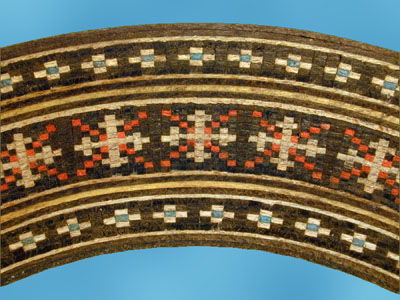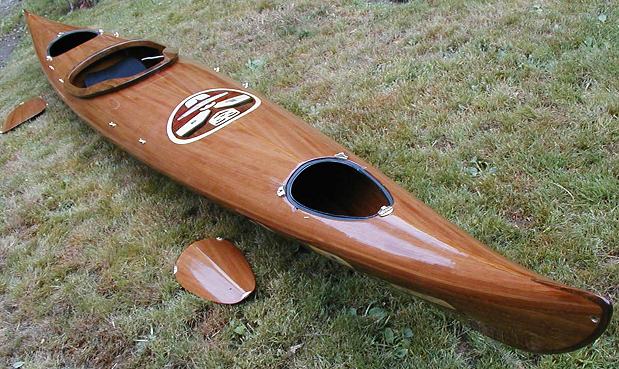 |
| rosette |
 |
Bowl by Jim Sprinkle includes copper metal with choice hardwoods |
Both processes incorporate disparate grains and colors of wood toward a single, planar surface. You see it on furniture, small goods, musical instruments, and even on bicycles. As I had attempted to use inlay on my table project this semester, I'll describing inlay and marquetry that appears on musical instruments.
In the Baroque period (16th century, as in Louis XIV), when rich people could afford music education in their own homes, music was composed for small ensembles (chamber music) to play in front of a small audience in a small space. Did I mention that the emphasis is on smallness and detail? I would imagine that the same applied to furniture then, when Islamic art had considerable influence on the visual Baroque style.Luthiers would imitate "strapwork" on lutes, any carving or arranging of wood so that it appears to be woven together geometrically. (Winternitz)
Marquetry refers to the application of a slice of wood to a bigger piece of wood to create an image. It's also called veneering. Where geometry is vastly repeated as on wood floors, the term parquetry is used. Buhl (German) or boulle (French) is the use of brass, shell, or other materials in achieving similar effect. Intarsia is the Italian word for combining woods in reference to the technique of knitting to weave different colors of yarn together. In addition to that, purfling is a technique used purely cosmetically to distinguish joined planes of wood by introducing a thin band of a different color, while "binding" is a band of inlay with used to mechanically close the edges of the instrument so that the end grain is no longer exposed, which means it is protected from cracking in the future.
Many terms in Western lutherie and music derive from Italian, Germanic or Franco vocabularies as a result of the widespread European mercantile and artistic influence in the 16th and 17th centuries. For instance, archette (bow), rosette (the embellished sound hole)... etc. It is hard to tell when inlay was first used because early uses of wood predate historical documentation in any part of the world. However, due to the volume of French and German scholarly writing on classical stringed instruments, their history is easy to acquire if you can read in those languages. (Try a query for "marquetry," "luthiers," and "instruments" within the King Library collections, and you'll see what I mean.)
Violins and cellos built by the famous luthier families of Europe, such as Stradivarius, tend to be appraised higher in the string market. It's due in part ; contemporary instruments of the same quality will not come as close in value. It is due partially to the acclaim of the family, the amount of money they made off of rich
Historical accounts of professional marquetry occur in rural towns of England, Japan, and Morocco. That's most of our
hile the lack of copious writing on the craft is attributed to the "folk" nature of building musical instruments- those who were considered experts in the field did not function traditionally as those writers or scholars who published literature. Trevor Semple and Anne Cole are exemplary luthiers who thoroughly document their processes for plebian curiosity- now, practically everyone with a computer and an internet connection is literally able to share in woodworking techniques, including the itty-bitty-teeny-tiny stuff.
 |
| Kayak by Jürgen Köppen, binding on the ends |
References:
Annette Otterstedt, "Investigating Green Marquetry on Bowed-String Instruments. The Leaves Be Greene," The Galpin Society Journal, Vol. 54 (May, 2001), 330-338.
Emanuel Winternitz, "The Evolution of the Baroque Orchestra," The Metropolitan Museum of Art Bulletin, New Series, Vol 12, No. 9 (May 1954), 258-275.
"Luthier," Wolfram|Alpha knowledgebase, 2011, http://www.wolframalpha.com/input/?i=luthier
"Marqueterie," Wolfram|Alpha knowledgebase, 2011, http://www.wolframalpha.com/input/?i=marqueterie
"Marquetry," Oxford Dictionaries, http://oxforddictionaries.com/definition/marquetry?q=marquetry (accessed 13 December 2011).
Maximiliaan Ruttern, "The Art Case Piano," The Galpin Society Journal, Vol 58 (May 2005), 168-172, 227-229.
Zachary Taylor, Marquetry & Inlay Handbook, Sterling Publishing Co, 2003.
2 comments:
Nice work. THere are a few portions of sentences left incomplete at the end that I found a little confusing, but interesting use of your Creative Arts background!
Download 16,000 Woodworking Plans & Projects
https://bit.ly/2ENQU1A
Woodworking guide offers anyone of any skill level the ability to build amazing projects. The guide is extra helpful because it offers more detailed explanations, videos and blueprints then your typical woodworker magazine.
Boat Plans ,
Book Case Plans ,
Baby Changing Table ,
Coat Rack ,
Cabin Plans ,
Cabinet Plans ,
Carport Plans ,
Cart Plans ,
Cat House Plans ,
CD/DVD Holder ,
Cellar Projects ,
Chair Plans ,
Chest Designs ,
Chicken Houses
Childrens Room Plans ,
Clock Plans ,
Coasters ,
Coffee Table Designs ,
Cold Frame Plans ,
Compost Bin ,
Computer Desk ,
Containers ,
Cradle Projects ,
Small Crafts ,
Cutting Board ,
Deck Plans ..
Post a Comment